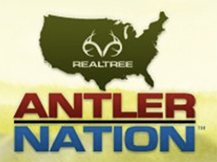Deer Hunting Regulations
General Regulations
Resident Deer Hunting License Privileges
ANNUAL CLASSES X, X3, XP, XJ, AND AHJ, LIFETIME CLASSES A-L, AB-L, AND XS*, MILITARY, DISABLED VETERAN, FORMER POW, SENIOR CITIZEN AND UNDERAGE:
entitles a hunter to take one deer during the archery or crossbow seasons, one antlered deer during the buck firearms season and one deer during the muzzleloader season.
Additional stamps must be purchased:
- to hunt an additional antlered deer in the buck firearms season: Class RG
- to hunt an additional deer during the archery or crossbow seasons: Class RB
- to hunt antlerless deer in antlerless season: Class N
- to hunt an additional deer in muzzleloader season: Class RM
- to hunt with a handgun: Class A1
ANNUAL CLASSES A AND AH(MUST ALSO HAVE A CLASS CS):
entitles the hunter to hunt one antlered deer during the buck firearms season.
Additional stamps must be purchased:
- to hunt an additional antlered deer in the buck firearms season: Class RG
- to hunt deer during the archery or crossbow seasons: Class BG
- to hunt an additional deer during the archery or crossbow seasons: Class RB
- to hunt deer in muzzleloader season: Class BG
- to hunt an additional deer in muzzleloader season: Class RM
- to hunt antlerless deer in antlerless season: Class N
- to hunt with a handgun: Class A1
Resident Landowner Privileges
West Virginia resident landowners may hunt on their own land without obtaining a license.
A resident landowner hunting on his/her own land without a license can take the same number of deer as a licensed hunter. A hunter (licensee or landowner) cannot take more than the number of deer allowed in the respective seasons.
After killing a deer as a landowner, a person cannot take another deer by use of a license for which the privilege has already been used.
Resident and Nonresident License Privileges with a Class DT Special Hunting and Fishing License for Persons with a Life-Threatening Condition
A resident or nonresident under age 21 who qualifies for and obtains a Class DT license, may hunt for and take the legal number of deer allowed in each season in compliance with county and statewide regulations without purchasing or otherwise obtaining any additional licenses or stamps, providing the Class DT license holder and assistant abides by all other pertinent laws and regulations. Class DT license holders must be accompanied by a parent, guardian, or with written consent of the parent or guardian, or any other competent licensed adult 21 years of age or older.
State Park Deer Seasons
Information available July 1 at the WV DNR website, District offices and State Parks. Application process will be on-line at WVdnr.gov.
Beech Fork State Park
October 31-November 2 and November 7-9, 2022
Cacapon Resort State Park
October 31-November 2 and November 7-9, 2022
North Bend State Park
October 24-26 and November 7-9, 2022
Twin Falls Resort State Park
November 7-9, 2022
Nonresident License Privileges
Nonresidents (ages 8 through 17) who have satisfactorily completed a Hunter Education Course may purchase a Class XXJ license or AAHJ license (without the training) and a Class CS/LE stamp are entitled to take one deer during the archery or crossbow seasons, one antlered deer during the buck firearms season, and one deer during the muzzleloader season.
Additional stamps must be purchased:
to hunt an additional antlered deer in the buck firearms season: Class RRG
to hunt an additional deer during the archery or crossbow seasons: Class RRB
to hunt antlerless deer in antlerless season: Class NN
to hunt an additional deer in muzzleloader season: Class RRM
All other nonresidents, except those who hold License Classes XXJ, AAHJ or DT, regardless of landowner status, must purchase an annual Class E or AAH license and a Class CS/LE stamp. This entitles the holder to hunt one antlered deer during the buck firearms season.
Additional stamps must be purchased:
to hunt an additional antlered deer in the buck firearms season: Class RRG• to hunt deer during the archery or crossbow seasons: Class UU
to hunt an additional deer during the archery or crossbow seasons: Class RRB•
to hunt deer in muzzleloader season: Class VV•
to hunt an additional deer in muzzleloader season: Class RRM•
to hunt antlerless deer in antlerless season: Class NN
to hunt on national forest lands: Class I• to hunt with a handgun: Class A1
Baiting and Feeding Regulations
It is illegal to bait or feed any wildlife on public land at any time.
Blaze Orange Requirement
Persons hunting in counties or portions thereof where a deer firearms season is presently open shall wear a blaze orange outer garment of at least 400 square inches. This applies to counties or parts thereof with the special youth/Class Q/QQ/XS antlerless deer season. This applies to the Mountaineer Heritage Season. This does not apply to waterfowl hunters and persons engaged in farming activities on their own land.
Hunting Hours and Restrictions
You may hunt deer from 1/2 hour before sunrise until 1/2 hour after sunset.
After a person has killed his/her legal daily or season limit of deer, they may not participate further in hunting deer with either a bow, crossbow or firearm the remainder of the day.
After killing the legal limit of deer, a hunter shall not be afield with any firearm with solid ball ammunition unless legally hunting bear, or shot shells containing larger than No. 4 shot unless legally hunting waterfowl using nontoxic shot.
It is legal to hunt small game during the muzzleloader season with a .22 caliber rimfire.
A hunter may take no more than three antlered deer during the regular deer seasons and the following Mountaineer Heritage Season combined.
Replacement Costs for Illegally Injuring or Killing Antlered Deer
In addition to the $500 replacement value of deer, the following cost shall also be forfeited to the state by any person who is convicted of violating any criminal law of this state and the violation causes the injury or death of antlered deer:
- For any deer in which the inside spread of the main beams on the antlers measured at the widest point equals 14” or greater but less than 16” – $2,500;
- For any deer in which the inside spread of the main beams on the antlers measured at the widest point equals 16” or greater but less than 18” – $5,000;
- For any deer in which the inside spread of the main beams on the antlers measured at the widest point equals 18” or greater but less than 20” – $7,500;
- For any deer in which the inside spread of the main beams on the antlers measured at the widest point equals 20” or greater – $10,000;
- Any person convicted of a second or subsequent violation of any criminal law of this state which violation causes the injury or death of antlered deer is subject to double the authorized range of replacement cost to be forfeited.
- Any person convicted pursuant to the replacement costs above shall also be subject to a revocation of hunting and fishing privileges for a period of five years.
West Virginia Chronic Wasting Disease (CWD) Containment area
Includes all of Berkeley, Grant, Hampshire*, Hardy*, Jefferson, Mineral and Morgan counties.
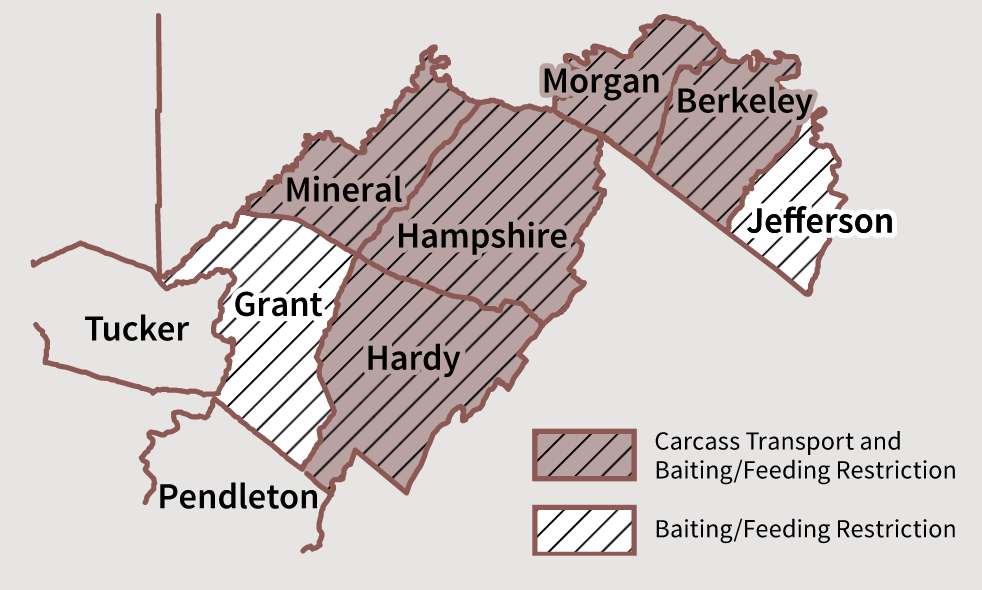
CARCASS TRANSPORT REGULATIONS
Hunters are prohibited from transporting dead cervids (deer, elk, etc.) or their parts beyond the boundaries of Berkeley, Hampshire, Hardy, Mineral and Morgan counties (shaded area) except for the following:
- meat that has been boned out,
- quarters or other portions of meat with no part of the spinal column or head attached,
- cleaned hide with no head attached,
- clean skull plate (no meat or tissue attached) with antlers attached,
- antlers with no meat or tissue attached, and
- finished taxidermy mounts
Hunters may transport whole cervid carcasses that were not killed inside Berkeley, Hampshire, Hardy, Mineral and Morgan counties through the containment area.
BAITING/FEEDING RESTRICTION REGULATIONS
It is illegal to bait or feed cervids or other wildlife in a “Containment Area” as determined by the Director and established for the management, control or eradication of chronic wasting disease or other wildlife diseases. Song and insectivorous birds may be fed, provided that such feeding shall not cause, or be done in a manner that would be reasonably anticipated to cause a congregation of cervids or other wildlife. Provided further, that captive cervids may be fed inside cervid facilities permitted by the state Department of Agriculture.
*See the Designated CWD Sampling Stations for Hampshire and Hardy counties
Firearms/Bows/Crossbows and Equipment
It is illegal to hunt deer with:
- a shotgun using ammunition loaded with more than one solid ball, or a rifle using rimfire ammunition of less than .25 caliber.
- a fully automatic rifle, shotgun or handgun.
- a handgun using a straight-walled case of less than .357 magnum cartridge or a bottle-necked case of less than .24 caliber.
- a muzzleloader of less than .38 caliber during the muzzleloader deer season.
- both a gun and a bow or with a gun and an arrow, except that a person who is not prohibited from possessing firearms by law may carry a firearm for self-defense.
- a crossbow that does not have:
- a draw weight of at least 125 pounds.
- a working safety.»bolts and arrows at least 16 inches long, including the insert and the nock.
- broadheads with at least two sharp-cutting edges at least 3/4 inch in width.
- a bow with arrows with broadheads having less than two sharp-cutting edges, measuring less than 3/4 inch in width.
- a bow locking device, except with a modified bow permit issued by the Director.
- an arrow with an explosive, drug-laced or poisoned head or shaft.
- anything other than a bow, crossbow or single-shot muzzleloader on Green Bottom and Fox Forest WMAs.
- an electronic call.
- a bow or crossbow on Bright McCausland Homestead WMA.
Field Tagging, Checking and Transporting
Each person killing a deer must attach a completed field tag to the deer or remain with the deer and have upon their person a completed field tag before moving the carcass from where it was killed. A person who does not have a field tag must make one. This tag must bear the hunter’s name, address, hunting license number (if required) and the date, time and county of kill. Immediately upon arriving at a residence, camp, hunting lodge, vehicle or vessel, the field tag shall be attached to the deer and must remain on the carcass until it is tagged with a DNR-issued game tag number.
Each deer shall be electronically registered and a DNR-issued 13-digit game check number, hunter’s name and address shall be attached to the deer:
- before it is transported beyond the county adjacent to the county of kill,
- within 72 hours from when it was killed or 24 hours from the close of the respective season, whichever comes first.
The game tag number, hunter’s name and address shall remain on the deer until it is dressed for consumption.
A hunter may harvest two deer on the same day, but only one antlered buck may be harvested on the same day. The first deer does not have to be electronically registered prior to harvesting the second deer in the same day. However, all deer legally harvested must be electronically registered and legally tagged prior to hunting during a subsequent day.
No person may transport or possess wildlife killed by another hunter, unless the wildlife or parts thereof is accompanied by a paper tag filled out legibly bearing the signature, address, date of kill, hunting license number (if required) and the DNR-issued 13-digit game check number (if required) of the hunter who killed the wildlife. The tag shall also specify the species and quantity of wildlife.
WV GAMECHECK
All hunters must check big game electronically in one of three ways:
- online at WVdnr.gov
- at a license agent
- by calling 844-WVcheck (844-982-4325)
You must have your DNR ID number (which is valid for your lifetime) to successfully check big game, beaver, otter, fisher and bobcat.TIP: Hunters and trappers need to make sure their DNR ID account is updated with current information and password before going afield.
CWD Testing Available
Adult deer harvested by hunters in the CWD Containment Area (see map to the left) during any deer season may be tested at the DNR District 2 Office at 1 Depot St., Romney, WV (Hampshire County), or at Sleepy Creek WMA manager's headquarters (Berkeley County) (304-754-4449).
Hunters should call ahead to make sure staff will be available to collect samples before coming to Romney for testing. Staff will be available during the first two days of buck season, and no call is necessary during that time.
Antlerless Firearms season Deer
All West Virginia residents must purchase a Class N stamp to hunt during the antlerless season with the following exceptions:
- Resident landowners may hunt antlerless deer on their land without a license provided the land is in a county or part thereof open to antlerless deer hunting.
- Resident landowners, their resident children or resident parents do not have to live on the property. However, a resident tenant must permanently live on the land.
- Resident stockholders of resident corporations formed for the primary purpose of hunting or fishing who own in fee no less than 1,000 acres may hunt antlerless deer on their own land, provided the land is in a county or part thereof open to antlerless deer hunting.
- Residents or nonresidents who hold Class DT licenses are not required to purchase Class N or NN stamps but must abide by all other antlerless regulations.
All nonresidents, military personnel, senior citizens, Class Q and QQ, Class XS, disabled veterans, former POWs and underage hunters not exempted must purchase a Class N or NN stamp to hunt antlerless deer during the antlerless season.
- Class N or NN stamps may be purchased at any license agent, the DNR offices in South Charleston and Elkins, or on the DNR website.
- Class N or NN stamps are nontransferable. Class N or NN stamps are not county specific, but in limited resident counties, State Forests or WMAs, the Class N stamp must be accompanied by a valid eligibility card.
- During the antlerless season, a Class N or NN stamp holder may substitute a bow or crossbow for a firearm to take antlerless deer
A hunter may harvest two deer on the same day, but only one antlered buck may be harvested on the same day. The first deer does not have to be electronically registered prior to harvesting the second deer in the same day. However, all deer legally harvested must be electronically registered and legally tagged prior to hunting during a subsequent day.
No person may actively participate (i.e., drive) in any manner in hunting antlerless deer without a valid Class N or NN stamp or otherwise being exempt from having a Class N or NN stamp.
Counties or parts thereof with a Bag Limit of Three Class N or NN Deer in Antlerless Season and Counties with a Bag Limit of Three Class N or NN Deer with Special Regulations
Counties or parts thereof with a bag limit of three Class N or NN deer in antlerless season having a special regulation
There are 10 counties or parts thereof where a hunter may take three antlerless deer during the antlerless season by purchasing multiple Class N or NN stamps. Hunters may take up to three antlerless (Class N or NN) deer in each county or part thereof not to exceed the bag limit specified in each county or part thereof and not to exceed the annual statewide bag limit of three antlerless (Class N or NN) deer. There are 10 counties or parts thereof that require hunters to take an antlerless deer within the county, which may be taken during any regular deer season open to antlerless deer hunting, before killing a second antlered deer within the county. This regulation applies across all the combined regular deer seasons and the Mountaineer Heritage Season.
Counties or parts thereof with a bag limit of three Class N or NN deer in antlerless season
There are 18 counties or parts thereof where a hunter may take three antlerless deer during the antlerless season by purchasing multiple Class N or NN stamps. Hunters may take up to three antlerless (Class N or NN) deer in each county or part thereof not to exceed the bag limit specified in each county or part thereof and not to exceed the annual statewide bag limit of three antlerless (Class N or NN) deer. See for antlerless regulations on WMAs and other public lands.
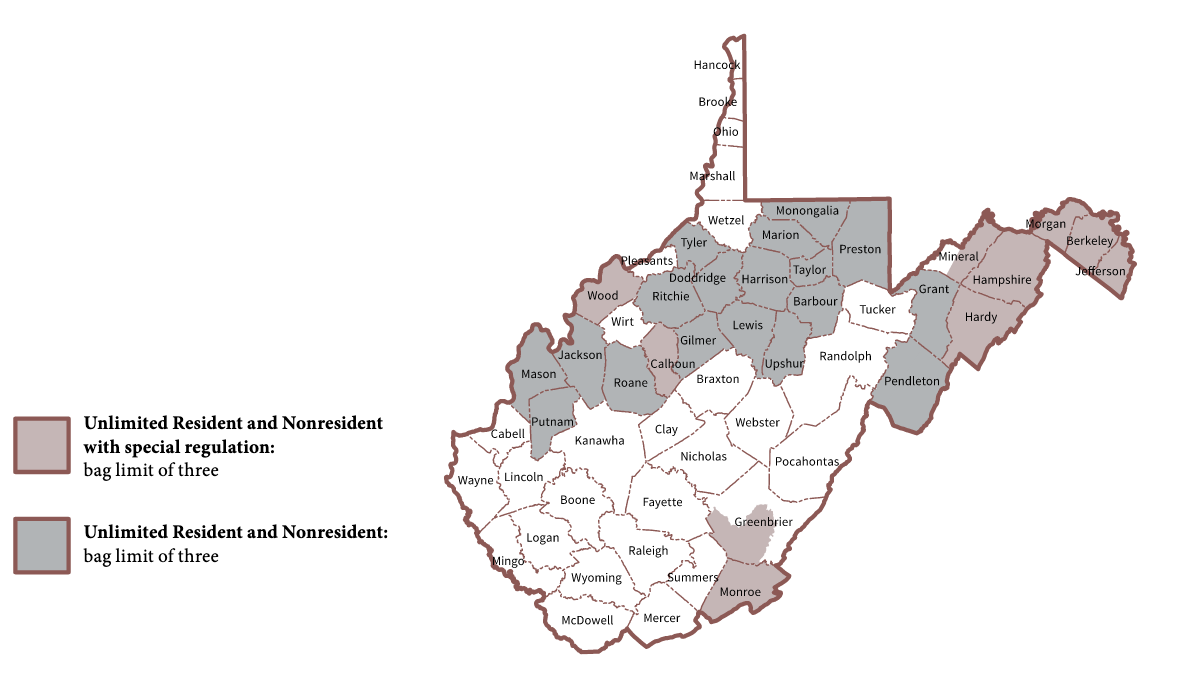
Concurrent Hunting during the Antlerless Deer Season
During antlerless season, concurrent hunting for small game (except during the first three days of the buck firearms season) and bear (where the season is open) is legal; however, no hunter except those legally hunting deer or bear shall be afield with a firearm with solid ball ammunition or shot shells containing larger than No. 4 shot, except for waterfowl hunters using nontoxic shot.
Concurrent archery and crossbow hunting for antlered and antlerless deer is legal during the antlerless season subject to all archery and crossbow deer hunting regulations. All persons hunting during deer firearms seasons (except those engaged in farming activities on their own land and waterfowl hunters) must wear at least 400 square inches of blaze orange as an outer garment.
Concurrent waterfowl hunting is legal (see separate WVDNR Migratory Bird Hunting Regulations publication).
Counties or parts thereof, State Forests and/or WMAs with Limited Resident and Nonresident Class N or NN Permits, and Unlimited Resident and Nonresident Class N or NN with a Bag Limit of One
Counties or parts thereof with a bag limit of one Class N or NN deer in antlerless season
Nineteen counties or parts thereof have an unlimited number of Class N or NN stamps for resident and nonresident antlerless deer hunting. No application is necessary for these counties. Hunters may take one antlerless (Class N or NN) deer in each county or part thereof in this group of counties, not to exceed the annual statewide bag limit of three antlerless (Class N or NN) deer.
Counties or parts thereof and public lands with limited resident and nonresident hunting for Class N or NN deer in antlerless season
There are six counties or parts thereof with resident Class N or nonresident Class NN antlerless deer hunting with prior permit application in 2021. One wildlife management area (WMA), National Forest in Randolph and Pocahontas counties and two state forests (SFs) have a limited number of Class N or Class NN stamps for antlerless deer hunting. To be eligible to hunt in one of these counties or on one of these WMAs, portions of National Forest or SFs, an application must be submitted online by August 13, 2021. Resident landowners do not need a permit to hunt on their own land. Successful applicants will receive notification from the DNR by mail and applicants can check online at WVdnr.gov beginning August 20. See for antlerless regulations on WMAs and other public lands.
In limited resident and nonresident antlerless WMAs and state forests, a hunter may take only one deer in the antlerless season.
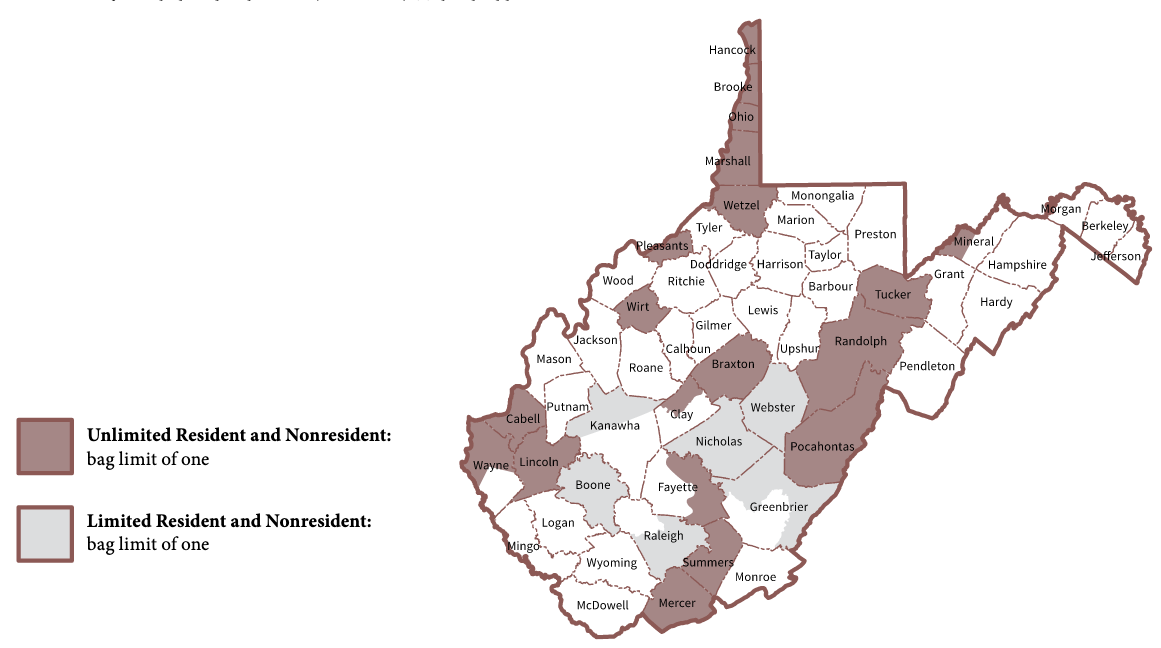
Split Counties – Maps/Descriptions
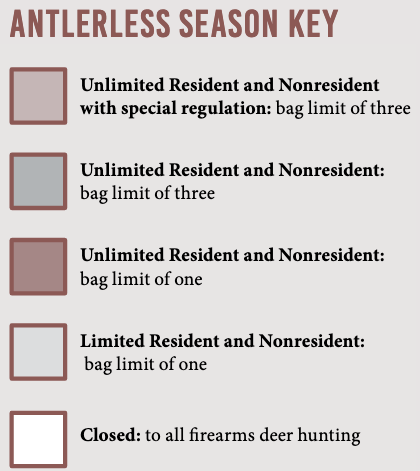
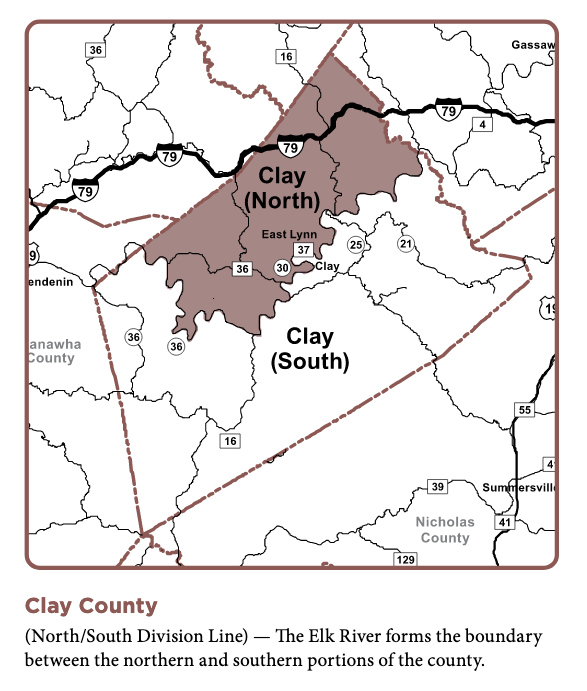
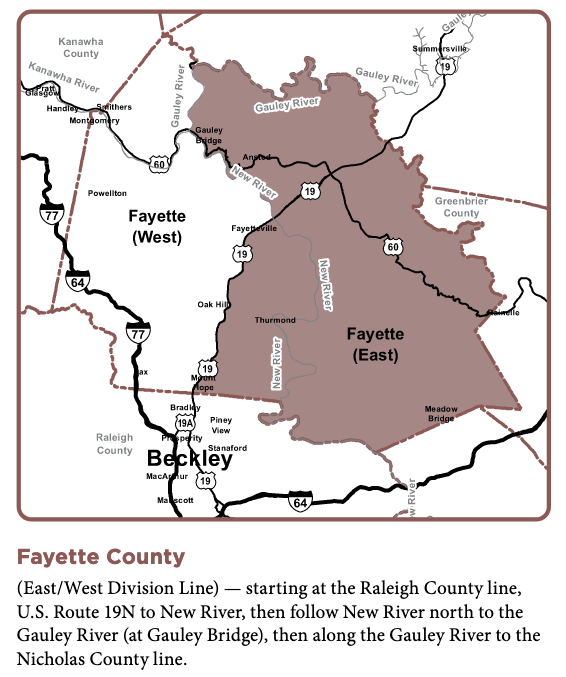
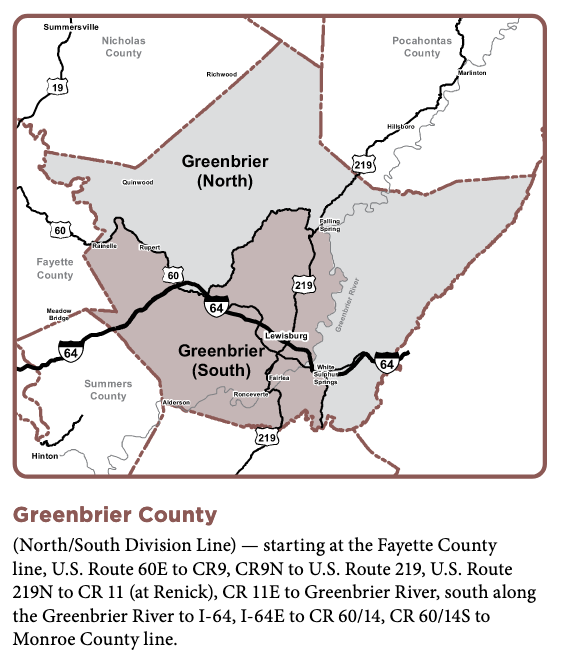
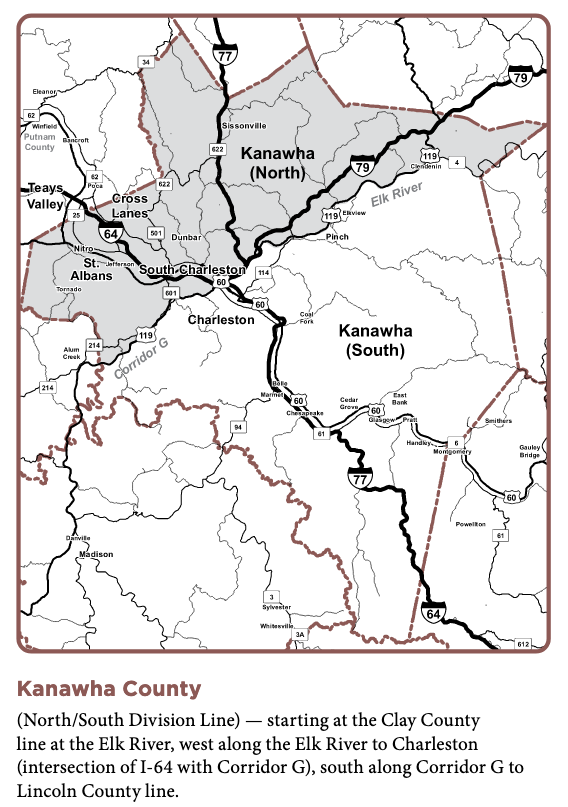
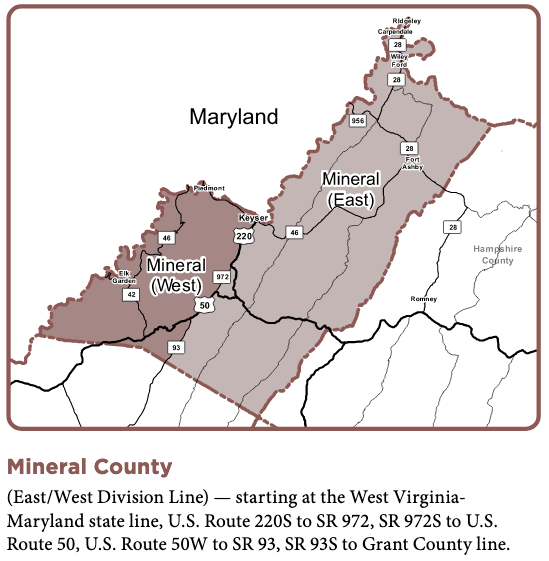
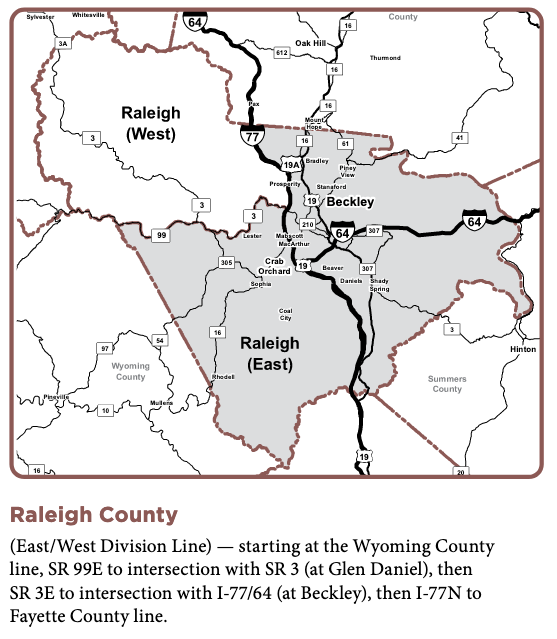
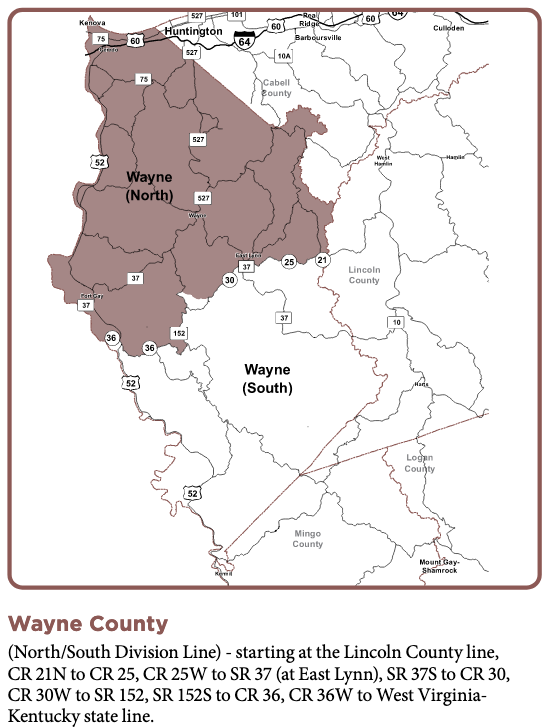
Archery and Crossbow Seasons
Daily Bag Limit: 1
Opening Date: November 22
Closing Date: December 5
Three deer may be taken with a bow or crossbow during the archery and crossbow seasons. One deer may be taken on one of the following valid base licenses or license combinations: resident license (Class X, Class X3, Class XP, Class XJ, Class AHJ, Class AB-L, Class A-L, Class XS, Classes A+CS+BG or Classes AH+CS+BG); or a free license (Military, Disabled Veteran, former POW, Senior Citizen or Class DT); or nonresident license (Classes E+CS/LE+UU, Classes AAH+CS/LE+UU, Classes XXJ+CS/LE, Classes AAHJ+CS/LE or Class DT). Underage residents and resident landowners hunting on their own land may take an archery or crossbow deer without a license. Up to two additional deer may be taken with Class RB or Class RRB stamps (one per stamp) or on a Class DT license or by resident landowners hunting on their own property. If two deer are taken on Class RB or RRB stamps, or on a Class DT license or by a resident landowner using those privileges, one of the two must be an antlerless deer taken in a county open to Class N antlerless hunting. Class DT license holders must be accompanied by a parent, guardian, or with written consent of the parent or guardian or any other competent licensed adult 21 years of age or older
A hunter may take no more than three antlered deer during the regular deer seasons and the following Mountaineer Heritage Season combined.
A hunter may harvest two deer per day, but only one antlered deer may be harvested per day. The first deer does not have to be electronically registered prior to harvesting the second deer in the same day. However, all deer legally harvested must be electronically registered and legally tagged prior to hunting during a subsequent day.
Deer of either sex may be hunted statewide with a bow or crossbow during the archery and crossbow seasons, except that crossbows are not permitted in Logan, McDowell, Mingo and Wyoming counties, except by the holders of Class Y/YY permits. A bow or a crossbow may be substituted for a firearm during any deer firearms season except that a bow or crossbow cannot be substituted in the muzzleloader season.
IT IS ILLEGAL TO:
- hunt with a crossbow that does not have:
- a draw weight of at least 125 pounds.
- a working safety.
- bolts and arrows at least 16 inches long, including the insert and the nock.
- broadheads with at least two sharp-cutting edges at least 3/4 inch in width.
- hunt deer with arrows with broadheads having less than two sharp-cutting edges, measuring less than 3/4 inch in width.
- use a bow-locking device, except with a modified bow permit issued by the Director.
- use an arrow with an explosive, drug-laced or poisoned head or shaft.
- use an electronic call to hunt deer.
- use a bow or crossbow on Bright McCausland Homestead WMA.
- be afield with both gun and bow or with gun and an arrow, except that a person who is not prohibited from possessing firearms by law may carry a firearm for self-defense.
Additional Deer Archery Stamps
Class RB and Class RRB
A resident may purchase only two Class RB stamps and a nonresident may purchase only two Class RRB stamps for the archery and crossbow seasons. The Class RB or Class RRB archery stamps must be purchased prior to the opening of statewide archery season.
- Only one deer may be taken with each Class RB or RRB stamp.
- Deer taken on a base license or license stamp combination or Class RB or RRB stamps may be checked in any order.
- Class RB or RRB stamps cannot be used for taking deer with a firearm
Two additional deer may be taken with Class RB or Class RRB stamps, by holders of Class DT licenses or by a resident landowner hunting on their own land during the archery and crossbow seasons. If two deer are taken on Class RB or Class RRB stamps, or on a Class DT license, or by a resident landowner using Class RB stamp privileges, one of the two must be an antlerless deer taken in a county open to Class N antlerless hunting.
There are 10 counties or parts thereof that require hunters to take an antlerless deer within the county, which may be taken during any regular deer season open to antlerless deer hunting, before killing a second antlered deer within the county. This regulation applies across all the combined regular deer seasons and the Mountaineer Heritage Season.
The annual limit for the four-county area of Logan, McDowell, Mingo and Wyoming counties is two archery deer, one of which must be antlerless. One Class RB or RRB stamp is valid in these counties, except if the first archery deer was taken in a county open to firearms deer hunting, then two deer (one must be antlerless) may be taken on Class RB or RRB stamps or a Class DT license in counties open to firearms deer hunting. The taking of archery antlerless deer during the buck firearms season is legal in these counties.
To take additional archery or crossbow deer, all residents except holders of Class DT licenses and resident landowners hunting on their own land are required to purchase Class RB stamps. All nonresidents except holders of Class DT licenses are required to purchase Class RRB archery stamps to take additional archery or crossbow deer.
WV CWD CONTAINMENT AREA

Concurrent hunting during Deer Archery and Crossbow Seasons
A bow hunter may take small game at any time the small game season is open, except the first three days of buck firearms season in counties having a buck firearms season. A crossbow hunter may take small game during the deer crossbow season, except the first three days of buck firearms season in counties having a buck firearms season.
Archery and crossbow hunting for antlered and antlerless deer are legal during muzzleloader deer season subject to all archery and crossbow deer hunting regulations. Additionally, archery and crossbow hunters must wear a blaze orange outer garment of at least 400 square inches during any deer firearms seasons.
Special Seasons and Restrictions
Urban Deer/Bear Archery/Crossbow Split Season
A special archery/crossbow deer/bear hunting split season is available between September 4−December 31, 2021, and January 10-31, 2022, to incorporated cities, towns, villages and incorporated homeowner associations. To implement the hunt, homeowner associations must submit a written request to the Director by March 1 of the hunt year. During this special season, seven deer may be taken which may include no more than two antlered bucks and the first deer must be antlerless. One bear may be taken and a DS Stamp is required, except for underage resident and resident landowners hunting on their own land. Deer and bear taken in the Urban Deer/Bear Archery/Crossbow Season shall not apply to the hunter’s regular archery and crossbow seasons bag limits. For information regarding this special archery deer/bear season, contact your local municipal government, homeowner association or the appropriate DNR office.
Older-aged Deer Management Areas
All antlered deer taken during archery and crossbow seasons on Beech Fork Lake, Bluestone Lake, Burnsville Lake, Little Kanawha River and McClintic WMAs, and Coopers Rock and Calvin Price State Forests must have a minimum outside antler spread of 14 inches (ear tip to ear tip). Only one antlered deer may be taken on each area for all seasons (archery, crossbow, buck firearms, muzzleloader and Mountaineer Heritage) combined. It is illegal to bait or feed wildlife on all public lands.
Wilson Cove Deer Study Area and Hillcrest Wildlife Management Area
See restrictions on the Wilson Cove Deer Study Area and Hillcrest Wildlife Management Area. It is illegal to bait or feed wildlife on public land at any time.
McClintic and Green Bottom Wildlife Management Areas – Controlled Waterfowl Hunting Areas
Hunting in the controlled waterfowl hunting area of McClintic and Green Bottom WMAs is restricted to waterfowl hunting during the early segment of the waterfowl season. Refer to the 2021-2022 WVDNR Migratory Bird Hunting Regulation available in August for season dates.
IT IS ILLEGAL TO:
- be afield with both gun and bow or with a gun and an arrow, except that a person who is not prohibited from possessing firearms by law may carry a firearm for self-defense.
- hunt with a crossbow that does not have:
- a draw weight of at least 125 pounds.
- a working safety.
- bolts and arrows at least 16 inches long, including the insert and the nock.
- broadheads with at least two sharp-cutting edges at least 3/4 inch in width.
- hunt deer with arrows with broadheads having less than two sharp-cutting edges, measuring less than 3/4-inch in width.
- use a bow-locking device, except with a modified bow permit issued by the Director.
- use an arrow with an explosive, drug-laced or poisoned head or shaft.
- to use an electronic call to hunt deer.
- use a bow or crossbow on Bright McCausland Homestead WMA.
Buck Firearms Season
Daily Bag Limit: 1
Opening Date: November 21
Closing Date: December 4
Only deer having one or both antlers more than 3 inches in length above the hairline are legal during the buck firearms season (see concurrent hunting for antlerless deer during buck firearms season).
Two deer may be taken with a gun, crossbow or bow during the buck firearms season. One may be taken on one of the following valid base licenses or license combinations: resident license (Class X, Class X3, Class XP, Class XJ, Class AHJ, Class AB-L, Class A-L, Class XS, Classes A+CS or Classes AH+CS); or free license (Military, Disabled Veteran, former POW, Class DT or Senior Citizen); or nonresident license (Classes E+CS/LE, Classes AAH+CS/LE, Classes XXJ+CS/LE, Classes AAHJ+CS/LE or Class DT). Underage residents and resident landowners hunting on their own land may take an antlered deer without a license. An additional deer may only be taken with a Class RG stamp, Class RRG stamp, Class DT license or by resident landowners hunting on their own property. Class DT license holders must be accompanied by a parent, guardian, or with written consent of the parent or guardian, any other competent licensed adult 21 years of age or older.
A hunter may take no more than three antlered deer during the regular deer seasons and the following Mountaineer Heritage Season combined.
A hunter may take no more than one antlered deer per day.
Legal firearms for hunting deer during the buck firearms season shall include:
- a rifle using centerfire ammunition.
- a rifle using .25 caliber or larger rimfire ammunition.
- a single-shot muzzleloading rifle, with or without scope, and muzzleloading pistol of .38 caliber or larger.
- a handgun using a straight-walled case of .357 magnum cartridge or larger or a bottle-necked case of .24 caliber or larger. A Class A1 handgun stamp is required.
- a shotgun loaded with solid ball ammunition.
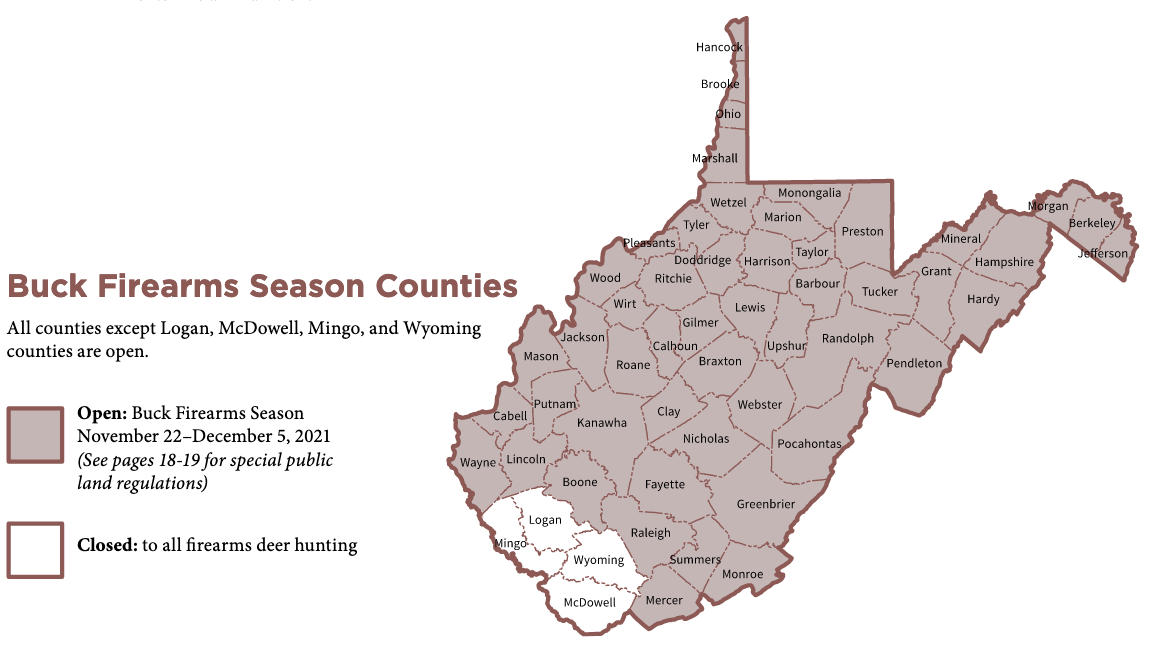
Additional Buck Firearms Season Gun Stamps
Class RG and Class RRG
During a calendar year, a resident may purchase only one Class RG stamp and a nonresident may purchase only one Class RRG stamp.
Only one deer may be taken with a Class RG or Class RRG stamp. The Class RG and Class RRG stamps must be purchased prior to the opening of buck firearms season. The Class RG and Class RRG stamps are valid for buck hunting in all counties open to buck firearms season.
To take an additional deer, all residents, except resident landowners hunting on their own land or holders of a Class DT license, are required to purchase a Class RG stamp. All nonresidents are required to purchase a Class RRG stamp or possess a Class DT license if they choose to take an additional deer.
There are 10 counties or parts thereof that require hunters to take an antlerless deer within the county, which may be taken during any regular deer season open to antlerless deer hunting, before killing a second antlered deer within the county. This regulation applies across all the combined regular deer seasons and the Mountaineer Heritage Season.
Deer taken on a base license or license stamp combination or Class RG or RRG stamps may be electronically registered in any order.
Concurrent Hunting during Buck Firearms Deer Season
Antlerless deer hunting is legal on private land in 51 counties or parts thereof and all public lands having an antlerless season November 22–December 5, 2021. To hunt antlerless deer during the buck firearms season, a valid Class N or NN stamp or Class DT license is required for all hunters except for resident landowners hunting on their own land. A hunter may harvest two deer per day, but only one antlered deer may be harvested per day. The first deer does not have to be electronically registered prior to harvesting the second deer in the same day. However, all deer legally harvested must be electronically registered and legally tagged prior to hunting during a subsequent day.
Small game hunting is prohibited during the first three days of buck firearms season in all counties having a buck firearms season; provided, waterfowl hunting is legal on lakes, rivers and waterways during the open waterfowl season, bear hunting is legal in specified counties, and coyote hunting is legal. The trapping of furbearing animals is permitted during the first three days of buck firearms season. Small game hunting is legal during open small game seasons beginning November 25, 2021. While hunting small game during the buck firearms season, No. 4 shot or smaller and slugs may be carried with a shotgun only if the hunter is legally hunting deer or bear.
A combination rifle-shotgun (over-under, etc.) is legal for deer hunting and concurrent small game hunting.
After killing the legal daily or season bag limit of deer, a hunter shall not be afield with any firearm with solid ball ammunition (unless legally hunting bear) or shot shells containing larger than No. 4 shot. Waterfowl hunters may use nontoxic shot larger than No. 4.
It is illegal to hunt small game during the buck firearms season with any centerfire, with any rimfire larger than .22 caliber, or with a shotgun using solid ball ammunition or shot larger than No. 4 in a county that is not open to buck firearms season.
Archery and crossbow hunting for antlered and antlerless deer is legal during buck firearms season subject to all archery and crossbow deer hunting regulations. A bow or a crossbow may be substituted for a firearm to take antlered deer, or if hunting on a Class N or NN stamp or Class DT license, antlerless deer may be taken during the buck firearms season on private land in specified counties and on specified public lands.
All persons hunting during a deer firearms season, except those engaged in farming activities on their own land and waterfowl hunters, must wear at least 400 square inches of blaze orange as an outer garment.
Special Seasons and Restrictions
Wilson Cove Deer Study Area and Hillcrest Wildlife Management Area
Wilson Cove Deer Study Area, located in Hardy County on the George Washington National Forest, and Hillcrest WMA, located in Hancock County, will have a special deer muzzleloader season November 22–December 5, 2021. During this period, only single shot muzzleloaders, including “in-lines” of .38 caliber or larger, are legal for deer hunting on these areas. These two areas will not be open to the traditional buck firearms season. All muzzleloader season license requirements apply and harvested deer must be electronically registered as a Muzzleloader Season harvest. Only one antlered deer may be taken on each area for all seasons (archery, crossbow, muzzleloader and Mountaineer Heritage) combined.
Older-aged Deer Management Areas
All antlered deer taken on Beech Fork Lake, Bluestone Lake, Burnsville Lake, Little Kanawha River and McClintic WMAs, and Coopers Rock and Calvin Price State Forests must have a minimum outside antler spread of 14 inches (ear tip to ear tip). Only one antlered deer may be taken on each area for all seasons (archery, crossbow, buck firearms, muzzleloader and Mountaineer Heritage) combined. It is illegal to bait or feed wildlife on all public lands.
Muzzleloader Season
Daily Bag Limit: 2
Opening Date: December 12
Closing Date: December 18
Two deer may be taken with a muzzleloader during the muzzleloader season. One may be taken on one of the following valid base licenses or license combinations: resident license (Class X, Class X3, Class XP, Class XJ, Class AHJ, Class AB-L, Class A-L, Class XS, Classes A+CS+BG or Classes AH+CS+BG); or a free license (Military, Disabled Veteran, former POW, Class DT or Senior Citizen); or nonresident license (Classes E+CS/LE+VV, Classes AAH+CS/LE+VV, Classes XXJ+CS/LE, Classes AAHJ+CS/LE or Class DT). Underage residents and resident landowners hunting on their own land may take a muzzleloader season deer without a license. An additional muzzleloader season deer may only be taken with a Class RM or RRM stamp, a Class DT license or by a resident landowner hunting on his/her own land. Class DT license holders must be accompanied by a parent, guardian, or with written consent of the parent or guardian, or any other competent licensed adult 21 years of age or older.
Muzzleloader season hunting for antlered deer is legal in all counties open to the buck firearms season. A deer of either sex may be taken in the muzzleloader season in all counties or parts thereof open to the Class N season. One additional deer may be taken on a Class RM or RRM stamp or a Class DT license in all counties having the muzzleloader season.
In the muzzleloader season, only single-shot muzzleloaders, including “in-lines” of .38 caliber or larger, are legal. Telescopic sights are legal. A firearm that has been converted into a muzzleloader by use of a plug, or a double-barreled or swivel-barreled muzzleloader is illegal for deer hunting during the muzzleloader season.
When being transported in or on a vehicle, muzzleloaders will be considered unloaded: when uncapped; when the priming charge is removed from the pan; or if they have an electronic ignition with the battery removed.
A hunter may take no more than three antlered deer during the regular deer seasons and the following Mountaineer Heritage Season combined.
A hunter may harvest two deer per day, but only one antlered deer may be harvested per day. The first deer does not have to be electronically registered prior to harvesting the second deer in the same day. However, all deer legally harvested must be electronically registered and legally tagged prior to hunting during a subsequent day.
Use of Class RM and Class RRM Stamps and Class DT Licenses in the Muzzleloader Season
Only one Class RM or RRM stamp may be used in the muzzleloader season.
Only one deer may be taken with a Class RM or RRM stamp. The Class RM and RRM stamps must be purchased prior to the opening of the muzzleloader season.
To take an additional muzzleloader season deer, all residents, except resident landowners hunting on their own land and hunters who possess a Class DT license are required to purchase a Class RM stamp. All nonresidents, except holders of a Class DT license, are required to purchase a Class RRM stamp if they choose to take an additional muzzleloader deer.
Class RM and Class RRM stamps or a Class DT license may be used to take one additional deer in the muzzleloader season in all counties having the muzzleloader season. See for muzzleloader season regulations on WMAs and other public lands.
Deer taken on a base license or license stamp combination or Class RM or RRM stamps may be checked in any order.
Class RM, RRM stamps or Class DT licenses may be used to take one antlered deer in all counties having the muzzleloader season OR;
Class RM, RRM stamps or Class DT licenses may be used to take one either-sex deer in the 46 counties or parts thereof having a Class N or NN antlerless season bag limit of one unlimited or three antlerless (Class N) deer. See for muzzleloader regulations on WMAs and other public lands.
Concurrent waterfowl hunting is legal (see separate WVDNR Migratory Bird Hunting Regulations publication).
There are 10 counties or parts thereof that require hunters to take an antlerless deer within the county, which may be taken during any regular deer season open to antlerless deer hunting, before killing a second antlered deer within the county. This regulation applies across all the combined regular deer seasons and the Mountaineer Heritage Season.
Concurrent Hunting during Muzzleloader Season
Concurrent archery and crossbow hunting for antlered and antlerless deer is legal during the muzzleloader season subject to all archery and crossbow deer hunting regulations.
Concurrent hunting is permitted during the muzzleloader season. It is illegal to be afield with solid-ball ammunition or shot larger than No. 4 during the muzzleloader season except for those persons legally hunting bear, and for waterfowl hunters using nontoxic shot. All persons hunting during deer firearms seasons (except those engaged in farming activities on their own land and waterfowl hunters) must wear at least 400 square inches of blaze orange as an outer garment.
It is legal to hunt small game with .22 caliber or smaller rimfire during the muzzleloader season.
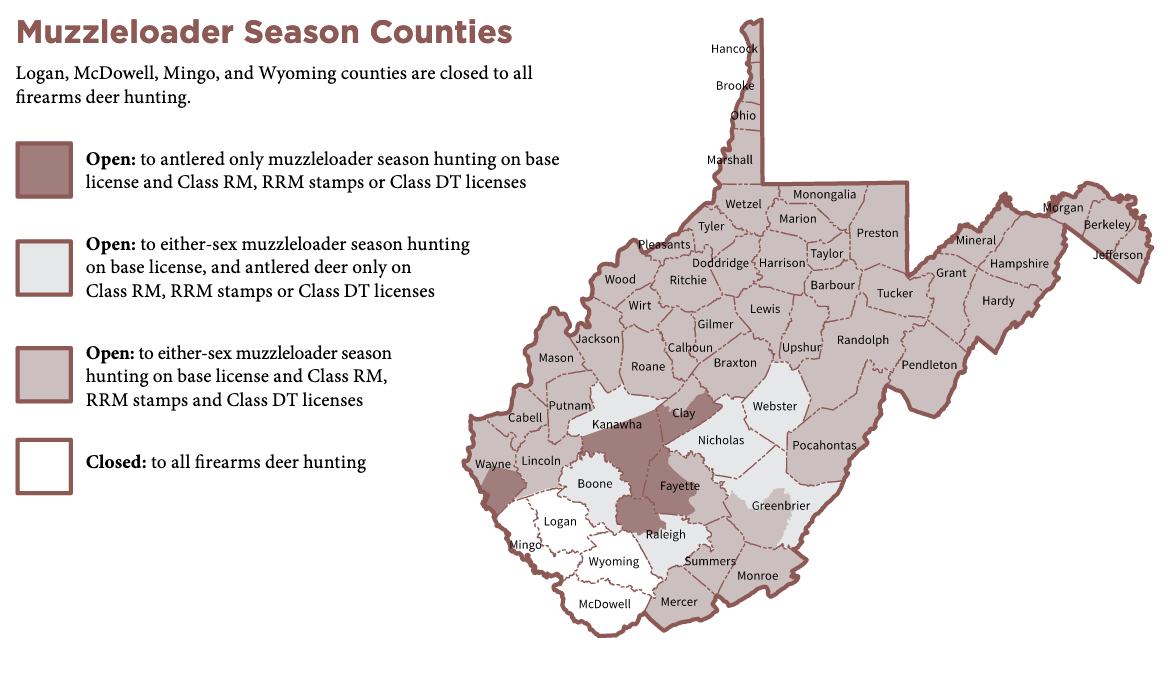
Special Seasons and Restrictions
Wilson Cove Deer Study Area and Hillcrest Wildlife Management Area
Wilson Cove Deer Study Area, located in Hardy County on the George Washington National Forest, and Hillcrest WMA, located in Hancock County, will have a special deer muzzleloader season November 21–December 4, 2022. During this period, only single shot muzzleloaders, including “in-lines” of .38 caliber or larger, are legal for deer hunting on these areas. These two areas will not be open to the traditional buck firearms season. All muzzleloader season license requirements apply and harvested deer must be electronically registered as a Muzzleloader Season harvest. Only one antlered deer may be taken on each area for all seasons (archery, crossbow, muzzleloader and Mountaineer Heritage) combined.
Older-aged Deer Management Areas
All antlered deer taken on Beech Fork Lake, Bluestone Lake, Burnsville Lake, Little Kanawha River and McClintic WMAs, and Coopers Rock and Calvin Price State Forests must have a minimum outside antler spread of 14 inches (ear tip to ear tip). Only one antlered deer may be taken on each area for all seasons (archery, crossbow, buck firearms, muzzleloader and Mountaineer Heritage) combined. It is illegal to bait or feed wildlife on all public lands.
Special Split Youth, Class Q/QQ and Class XS SEASON
October 16-17 and December 26-27, 2021: Antlerless Deer Only
Only one antlerless deer may be taken per day. A bow or a crossbow can be substituted for a firearm during this season.
See special regulations for West Virginia Containment Area carcass transport and baiting, and for baiting and feeding wildlife on Older-aged Deer Management Areas.
It is illegal to bait or feed any wildlife on public land at any time.
The special split antlerless deer season for youth, Class Q/QQ and Class XS hunters will be held on private land in all counties having a firearms deer hunting season and on all public lands within these counties.
The bag limit of one antlerless deer per day will not count towards the hunter’s annual deer season bag limit. Also, an antlerless deer taken during the Youth, Class Q/QQ and Class XS season does not count toward the requirement to kill an antlerless deer before killing a second antlered deer in counties listed. A Class N or NN stamp is not required by youth hunters hunting during this special split antlerless season. A Class N stamp is not required by seniors with a Class XS license. Each deer taken must be field tagged and electronically registered within 24 hours of the close of each portion of this special split season and before hunting an additional deer.
Youth, Class Q/QQ and Class XS season participants and all other hunters hunting on private land or on any of the public lands during the special youth, Class Q/QQ and Class XS deer season, with the exception of waterfowl hunters and persons engaged in farming activities on their own land, must wear at least 400 square inches of blaze orange as an outer garment.
Youth hunters:
- must be at least 8 and less than 18 years old; youth hunters age 15-17 must comply with all licensing requirements, but Class N or NN stamp not required,
- between the ages 8-14 must be accompanied by a licensed adult, who must also wear 400 square inches of blaze orange, cannot carry a gun, a crossbow or a bow and must remain near enough to the youth to render advice and assistance. All accompanying adult nonresidents must possess a Class E license + CS/LE stamp.
and, if a nonresident youth,
- possess Class XXJ license + CS/LE stamp, Class AAHJ + CS/LE stamp or Class DT license.
Senior hunters:
- must be a resident 65 years of age or older and possess a Class XS license.
Class Q or QQ hunters must possess:
if a resident,
- Class Q permit plus one of the following:
- Class A license + CS stamp or
- Class X, X3, XP, AH, XJ, AHJ, XS, A-L or AB-L license or
- Free license (Military, Disabled Veteran, former POW, Senior Citizen or Class DT) or
- Be underage (must be accompanied by a licensed adult)
if a nonresident,
- Class QQ permit + Class E license + CS/LE stamp or
- Class QQ permit + Class AAH + CS/LE stamp or
- Class QQ permit + Class XXJ + CS/LE stamp or
- Class QQ permit + Class AAHJ + CS/LE stamp or
- Class QQ permit + Class DT
CWD–Questions and answers
What is CWD — Chronic Wasting Disease?
CWD is a neurological (brain and nervous system) disease of the deer family known to occur in limited geographical locations in North America and Europe. The disease belongs to a family of diseases known as transmissible spongiform encephalopathy (TSE). These diseases are caused by an abnormal form of a protein called a prion. There is no practical test of live animals to detect CWD, and there is no known treatment or vaccine.
How is it spread?
It is thought that the most common mode of transmission from an infected animal is via saliva, feces, urine and possibly other body secretions. The infectious prion persists in the environment. There is evidence that people moving live infected animals have spread the disease over long distances.
Is it dangerous to humans?
There currently is no convincing evidence that the agent of CWD affects humans. However, public health officials recommend that human exposure to the CWD agent be avoided as they continue to research the disease. This includes not eating meat from known infected animals or animals that appear sick.
Where has it been found?
As of May 2021, CWD has been detected in free-ranging deer and elk in portions of Arkansas, Colorado, Illinois, Iowa, Kansas, Maryland, Michigan, Minnesota, Mississippi, Missouri, Montana, Nebraska, New Mexico, New York, North Dakota, Pennsylvania, South Dakota, Tennessee, Texas, Utah, Virginia, West Virginia, Wisconsin, Wyoming, and Alberta and Saskatchewan, Canada. In addition, CWD has been found in captive/farmed elk and white-tailed deer in Colorado, Iowa, Kansas, Michigan, Minnesota, Missouri, Montana, Nebraska, New York, Ohio, Oklahoma, Pennsylvania, South Dakota, Texas, Wisconsin, and Alberta and Saskatchewan, Canada.
In West Virginia, CWD has been found in 451 white-tailed deer. Testing of road-kill deer in all WV counties has been continuous since 2002. The WVDNR, Wildlife Resources Section, in cooperation with various USDA certified laboratories has tested over 20,669 deer from West Virginia for CWD. As of May 2021, 404 deer from Hampshire County, seven from Hardy County, 23 from Berkeley County, nine from Mineral County and eight from Morgan County are the only animals found thus far to have the abnormal prion associated with CWD.
What is being done about CWD in WV?
CWD in West Virginia represents a significant threat to the state’s white-tailed deer. The disease does not create an immediate widespread die-off of deer, but if allowed to spread, will cause long-term damage to the herd. The DNR is taking action to gather more information on the prevalence and distribution of the disease in the area surrounding all known infected deer. The DNR also discourages supplemental feeding and baiting of deer statewide, bans these practices on public land, and also bans these practices anytime in Berkeley, Grant, Hampshire, Hardy, Jefferson, Mineral and Morgan counties. In addition there are restrictions on the disposal and transport of deer carcasses from Berkeley, Hampshire, Hardy, Mineral and Morgan counties within the WV containment area (see WV CWD containment area) and any deer brought into WV from states where CWD has been detected or from fenced enclosures. There are no proven solutions to combating CWD once present in free-ranging deer. Thus, future management actions will be adaptive and based on the findings of current and future surveillance.
WV’s Chronic Wasting Disease Containment Area
Includes all of Berkeley, Grant, Hampshire, Hardy, Jefferson, Mineral and Morgan counties (cross hatch counties above). It is illegal to bait or feed deer any time in the “Containment Area”. In addition, hunters are prohibited from transporting dead deer or their parts beyond the boundary of Berkeley, Hampshire, Hardy, Mineral, and Morgan counties (shaded counties above) within the containment area except for the following: meat that has been boned out, quarters or other portions of meat with no part of the spinal column or head attached, cleaned hide with no head attached, clean skull plate (no meat or tissue attached) with antlers attached, antlers with no meat or tissue attached, and finished taxidermy mounts. Hunters may transport cervid carcasses that were not killed inside the containment area through the containment area.
What can hunters do?
- If you kill or observe a severely emaciated (very skinny) deer or a deer that is obviously sick, or a deer with an ear tag, contact the WV DNR Wildlife Resources Section office nearest you.
- Do not feed or bait deer. These practices concentrate deer, increase the likelihood of spread of any disease present in the deer herd, and may introduce foreign contaminates via th e feed or bait.
- Harvest adequate numbers of antlerless deer to maintain deer populations in balance with natural food supplies. A deer population in balance with available habitat is healthier and less likely to spread diseases.
- Avoid using natural deer urine based lures in the environment and do not place these urine lures on the ground or on vegetation where deer can reach them.
- If you hunt deer or elk out of state bring back only boned out meat or quarters and thoroughly cleaned skull plates and antlers. This applies to all CWD-positive states, except for VA, MD, OH and PA where it applies only to the state designated CWD containment area or CWD disease management areas.
- If you hunt in Berkeley, Hampshire, Hardy, Mineral, or Morgan counties, see special regulations regarding carcass transport and disposal. Also, please cooperate with WVDNR requests for information and samples needed for CWD testing.
- If you kill a cervid (deer, elk, etc.) out of state in a fenced enclosure only boned out meat or quarters and thoroughly cleaned skull plates and antlers may be transported into the state.
Mountaineer Heritage Season
Season Limit: 1 Deer, 1 Bear and 1 Turkey
Opening Date: January 12, 2023
Closing Date: January 15, 2023
Deer
One either sex deer may be taken with a percussion side lock rifle or pistol, flintlock rifle or pistol, long bow or recurve bow during the Mountaineer Heritage season.
One deer may be taken on one of the following valid base licenses or license combinations: resident license (Class X, Class X3, Class XP, Class XJ, Class AHJ, Class AB-L, Class A-L, Class XS, Classes A+CS+BG or Classes AH+CS+BG); or a free license (Military, Disabled Veteran, former POW, Senior Citizen or Class DT); or nonresident license (Classes E+CS/LE, Classes AAH+CS/LE, Classes XXJ+CS/LE, Classes AAHJ+CS/LE or Class DT). Underage residents and resident landowners hunting on their own land may take a deer during the Mountaineer Heritage Season without a license. Class DT license holders must be accompanied by a parent, guardian, or with written consent of the parent or guardian or any other competent licensed adult 21 years of age or older.
A hunter may take no more than three antlered deer during the regular deer seasons and the following Mountaineer Heritage Season combined. Only one antlered deer may be taken during the Archery and Mountaineer Heritage Seasons combined in Logan, McDowell, Mingo and Wyoming counties.
Deer, Bear and Turkey
The Mountaineer Heritage Season is open statewide, but only long and recurve bows are legal in Logan, McDowell, Mingo and Wyoming counties during this season.
- Nonresident hunters must purchase a Class I stamp to hunt on National Forest land.
Only single-shot side lock or flintlock muzzleloading rifles with iron sights of .38 caliber or larger, single-shot side lock or flintlock muzzleloading pistols with iron sights of .38 caliber or larger, long bows and recurve bows are legal during the Mountaineer Heritage season. Telescopic sights are not permitted. In-line muzzleloaders and a firearm that has been converted into a muzzleloader by use of a plug, or a double-barreled or swivel-barreled muzzleloader is illegal for hunting deer, bear and turkey during this season.
Single shot side-lock and flintlock muzzleloader shotguns with iron sights may be used for taking a turkey during this season.
When being transported in or on a vehicle, muzzleloaders will be considered unloaded: when uncapped or when the priming charge is removed from the pan.
IT IS ILLEGAL TO:
- hunt with a crossbow or compound bow during the Mountaineer Heritage Season.
- hunt bears with the use of dogs during the Mountaineer Heritage Season. See for exception when tracking a mortally wounded deer or bear.
Hunting turkey with the use of bait and electronic calls is prohibited. The use of dogs for turkey hunting is legal during this season. Hunters harvesting a bear during the Mountaineer Heritage Season are required to submit a first premolar tooth.
CWD Containment Area
See for special regulations regarding deer carcass transport and baiting and feeding of wildlife within the West Virginia CWD Containment Area.
Special Seasons and Restrictions
See for restrictions on the Older-aged Deer Management Areas and Wilson Cove Deer Study Area and Hillcrest Wildlife Management Area. It is illegal to bait or feed wildlife on public land at any time.
Blaze Orange Requirement
Persons hunting during the Mountaineer Heritage Season shall wear a blaze orange outer garment of at least 400 square inches, with the exception of Logan, McDowell, Mingo and Wyoming counties. This does not apply to waterfowl hunters and persons engaged in farming activities on their own land.
REMINDER: You must have a 2023 hunting license to hunt during the Mountaineer Heritage Season in 2023. To purchase your license, go to a local license agent, area DNR office or WVdnr.gov.
